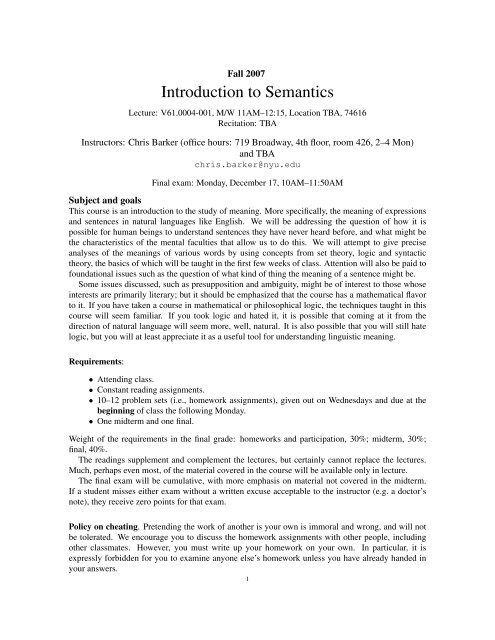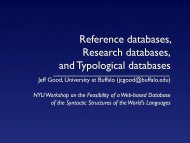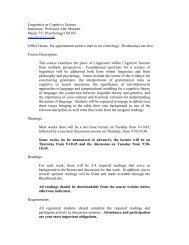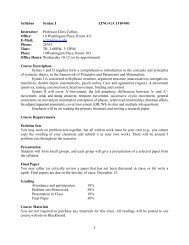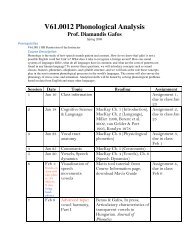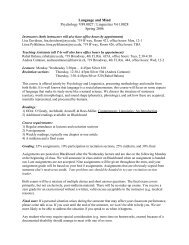Introduction to Semantics - NYU > Department of Linguistics
Introduction to Semantics - NYU > Department of Linguistics
Introduction to Semantics - NYU > Department of Linguistics
Create successful ePaper yourself
Turn your PDF publications into a flip-book with our unique Google optimized e-Paper software.
Fall 2007<strong>Introduction</strong> <strong>to</strong> <strong>Semantics</strong>Lecture: V61.0004-001, M/W 11AM–12:15, Location TBA, 74616Recitation: TBAInstruc<strong>to</strong>rs: Chris Barker (<strong>of</strong>fice hours: 719 Broadway, 4th floor, room 426, 2–4 Mon)and TBAchris.barker@nyu.eduFinal exam: Monday, December 17, 10AM–11:50AMSubject and goalsThis course is an introduction <strong>to</strong> the study <strong>of</strong> meaning. More specifically, the meaning <strong>of</strong> expressionsand sentences in natural languages like English. We will be addressing the question <strong>of</strong> how it ispossible for human beings <strong>to</strong> understand sentences they have never heard before, and what might bethe characteristics <strong>of</strong> the mental faculties that allow us <strong>to</strong> do this. We will attempt <strong>to</strong> give preciseanalyses <strong>of</strong> the meanings <strong>of</strong> various words by using concepts from set theory, logic and syntactictheory, the basics <strong>of</strong> which will be taught in the first few weeks <strong>of</strong> class. Attention will also be paid <strong>to</strong>foundational issues such as the question <strong>of</strong> what kind <strong>of</strong> thing the meaning <strong>of</strong> a sentence might be.Some issues discussed, such as presupposition and ambiguity, might be <strong>of</strong> interest <strong>to</strong> those whoseinterests are primarily literary; but it should be emphasized that the course has a mathematical flavor<strong>to</strong> it. If you have taken a course in mathematical or philosophical logic, the techniques taught in thiscourse will seem familiar. If you <strong>to</strong>ok logic and hated it, it is possible that coming at it from thedirection <strong>of</strong> natural language will seem more, well, natural. It is also possible that you will still hatelogic, but you will at least appreciate it as a useful <strong>to</strong>ol for understanding linguistic meaning.Requirements:• Attending class.• Constant reading assignments.• 10–12 problem sets (i.e., homework assignments), given out on Wednesdays and due at thebeginning <strong>of</strong> class the following Monday.• One midterm and one final.Weight <strong>of</strong> the requirements in the final grade: homeworks and participation, 30%; midterm, 30%;final, 40%.The readings supplement and complement the lectures, but certainly cannot replace the lectures.Much, perhaps even most, <strong>of</strong> the material covered in the course will be available only in lecture.The final exam will be cumulative, with more emphasis on material not covered in the midterm.If a student misses either exam without a written excuse acceptable <strong>to</strong> the instruc<strong>to</strong>r (e.g. a doc<strong>to</strong>r’snote), they receive zero points for that exam.Policy on cheating. Pretending the work <strong>of</strong> another is your own is immoral and wrong, and will notbe <strong>to</strong>lerated. We encourage you <strong>to</strong> discuss the homework assignments with other people, includingother classmates. However, you must write up your homework on your own. In particular, it isexpressly forbidden for you <strong>to</strong> examine anyone else’s homework unless you have already handed inyour answers.1
Tentative syllabus:The readings listed below, which are required, will be available at Unique Copy Center on Greenebetween Waverly and 8th.2Week Monday Wednesday1 (Labor Day, no class) <strong>Introduction</strong> [no reading]2 Ambiguity [Fromkin 7] Pragmatics [Grice]3 Entailment Word vs. world [Bowerman]4 Presupposition Roles and verbs [Talmy]5 Syntax [Szabolcsi] Questions, imperatives6 (Cols day, no class) Tense [Reichenbach]7 Aspect Comparison with other lgs. [Fromkin 7]8 MIDTERM Count/mass, telic/atelic [Fromkin 9]9 Determiners [Fromkin 7] Adverbs [Fromkin 8, Lewis]10 Scope [Fromkin 8] Binding [Reinhart]11 Tenses and pronouns [Partee] Implicit arguments [Fillmore]12 Negative polarity [Fromkin 8] Negative polarity (cont.)13 Focus [Keenan] Focus (cont.)14 Adjectives, intensionality [Fromkin 7] Speech acts15 Wacky stuff: metaphor, sarcasm, etc. Meaning and computationFinal exam: Monday, December 17, 10AM–11:50AMHelp. Your instruc<strong>to</strong>rs are committed <strong>to</strong> helping you succeed in this course. Please don’t hesitate <strong>to</strong>contact either <strong>of</strong> us. For questions about content or homework, sending email <strong>to</strong> both <strong>of</strong> us (ratherthan <strong>to</strong> just one) is the most efficient strategy. If our <strong>of</strong>fice hours are not convenient for you, we wouldbe happy <strong>to</strong> schedule an appointment. Additional assistance for this class is available <strong>to</strong> you free <strong>of</strong>charge at the College Learning Center located on the 1st Floor <strong>of</strong> Weinstein Hall (right behind JavaCity). For information on one-on-one and group peer tu<strong>to</strong>ring, please s<strong>to</strong>p by the CLC or go <strong>to</strong> theirwebsite: http://www.nyu.edu/cas/clc


